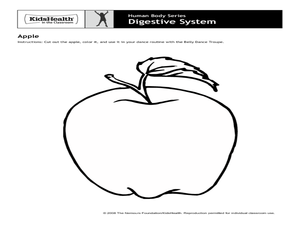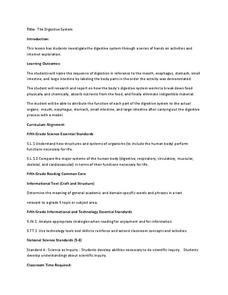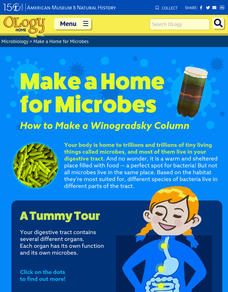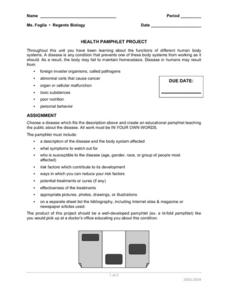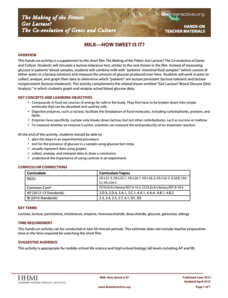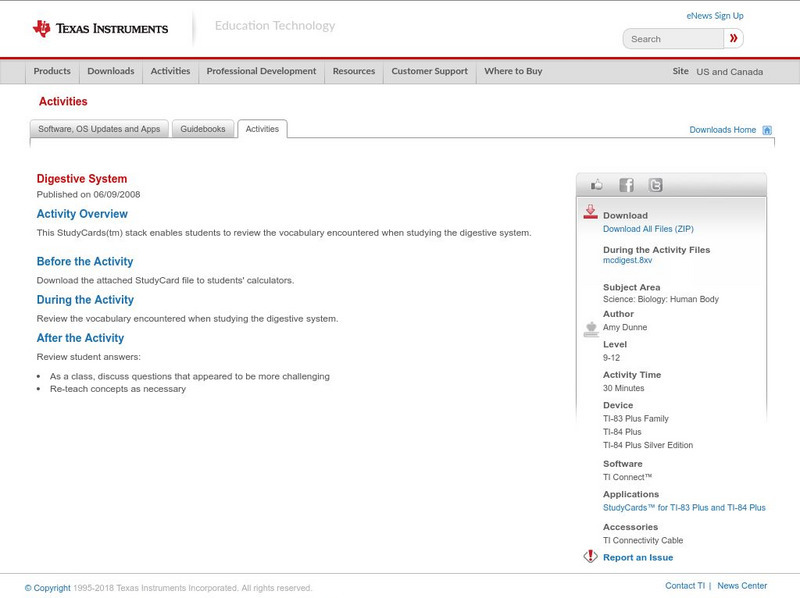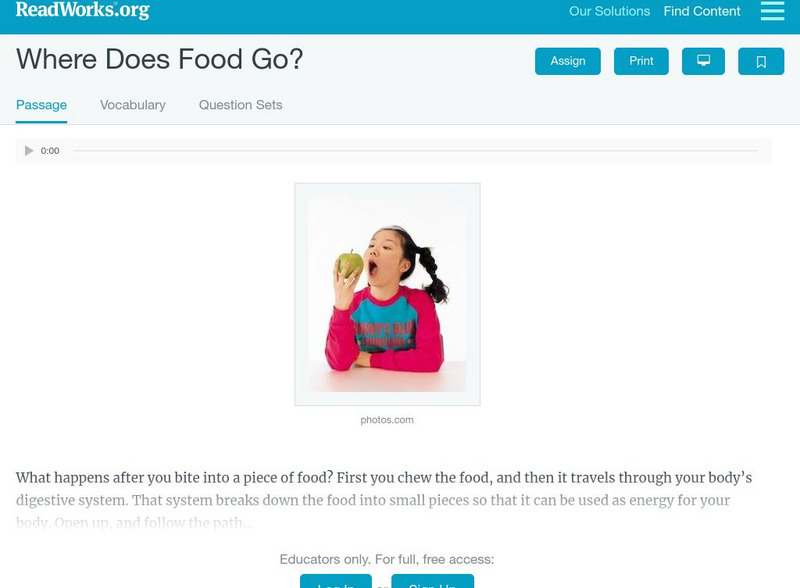Curated OER
Human Body Series - Digestive System
With articles entitled, "What's Puke?" and "What is a Fart?" this digestive system lesson is sure to be a gas! Elementary anatomists do a belly dance to illustrate how food moves through the digestive system and then design a board game...
Curated OER
The Digestive System
Discover how the human body's digestive system works with a brain and stomach friendly activity. Scholars taste test a variety of foods to find out how they behave once in the mouth. Class members then play a game called Move That...
Serendip
Structure and Function of Cells, Organs and Organ Systems
Cells of different organs have unique cell functions. Learn how cell functions vary depending on their roles in the body using an inquiry-based activity. Scholars analyze the cell structure to make comparisons to its functions, allowing...
Kenan
Respiratory System
Explore the respiratory system with a model. First, pupils build a set of lungs to experiment how they inflate and deflate. Then, they delve deeper into the topic with a web quest to discover new information about the nose, trachea, and...
American Museum of Natural History
Gusty: The Gut Microbiome Card Game
Build up your gut. Groups up to four play a card game to learn more about the microbiome in the gut. Learners try to build a healthy gut with their cards. The player acquiring six microbes without any pathogens wins the game.
Curated OER
Nervous System
Get to know the body's central nervous system through an engaging game of nervous system telephone. But this isn't your average game of telephone. Here, pupils must find a way to communicate a message to the brain without speaking....
Curated OER
Muscular and Skeletal Systems
How do muscles move bones? Find out using a built-in-class model. Pupils construct a hand model with paper and string, then follow a series of directions to explore the movement process. Discover additional information about the muscular...
Tracy Pendry
Cardiovascular/Circulatory System
Explore the circulatory system with a cardiovascular pump activity that promotes discovery and discussion as class members create a functioning model of the heart. Continue the learning process through a web quest showcasing the...
American Museum of Natural History
Make a Home for Microbes
Make a Winogradsky Column to discover how microbes live within the digestive tract. First, participants take a tour of the stomach. Then, gather supplies and start building using a variety of materials. Over eight to 10 weeks,...
Explore Biology
Health Pamphlet Project
Biology or health nuts select a disease to research and produce a pamphlet that can be used to inform the public. The tri-fold product is worth 100 points according to the included grading page.
Howard Hughes Medical Institute
Milk—How Sweet Is It?
Have you ever wondered why some people are lactose intolerant? Participants test simulated patients in a hands-on lab activity to find out! They learn about lactose intolerance by performing an experiment, analyzing data, and drawing...
Shanghai American School
Frog Dissection
Hop into exploration of a frog's anatomy with this collection of dissection resources. With the help of the included virtual dissection website, worksheets, and printable diagrams, students will have no problem navigating their way...
Lake Science Collaborative
Blood Circulation Simulation
Act out the circulation of blood in the body with an innovative activity. Kids act as either body parts or blood, and carry necessary nutrients and waste throughout different stations to represent the way that oxygen circulates.
Re Energy
Build Your Own Biogas Generator
What is biogas and how is it made? After examining background information about the sources of biogas and biogas generators, class members follow the provided information and build a biogas generator that can be used in the...
Teach Engineering
Optimize! Cleaner Energy Options for Rural China
What are the trade-offs when looking to get the most benefit from an energy source? Small groups compare the cost-to-emission levels of several energy sources by looking at the information graphically. The groups utilize this...
Serendip
How Do Biological Organisms Use Energy?
When an organism eats, how does food become energy? Young biologists follow glucose through the process of cellular respiration to the creation of ADP using a discussion-based activity. The resource also highlights conservation of mass...
National Cancer Institute at the National Institutes of Health
Seer Training Modules: Introduction to the Digestive System
Self-guided learning activity where students learn about the structure and function of the human digestive system. There is a short quiz at the end of the lesson to check for understanding.
Texas Instruments
Texas Instruments: Digestive System
This StudyCard stack enables students to review the vocabulary encountered when studying the digestive system.
National Cancer Institute at the National Institutes of Health
National Cancer Institute: Regions of the Digestive System: Mouth (Oral Cavity)
Find information on the mouth (oral cavity), lips and cheeks, palate, tongue, and teeth. This website provides brief descriptions of the roles of each, as well as an image of the mouth with its parts labelled.
TeachEngineering
Teach Engineering: Protect That Pill
Students reinforce their knowledge of the different parts of the digestive system and explore the concept of simulation by developing a pill coating that can withstand the churning actions and acidic environment found in the stomach....
Curated OER
Kids Health: My Body
For elementary school children, this page presents information about lungs, muscles, digestive system, teeth, skin, tongue, hair, heart, and more.
Treehut
Suzy's World: Digestion
Use this site to find out what happens when you eat and try an experiment involving digestion.
Curated OER
Kids Health: How the Body Works Movies and Activities
Short, colorful movies explain each of the body's systems: skeletal, cardiovascular, digestive, urinary, respiratory, endocrine, skin, immune, muscular, and nervous. Once you've seen the movie, click on the Activity Page link for...
Read Works
Read Works: Where Does Food Go?
[Free Registration/Login Required] This informational text passage explains the process of food digestion. This passage is a stand-alone curricular piece that reinforces essential reading skills and strategies and establishes scaffolding...
